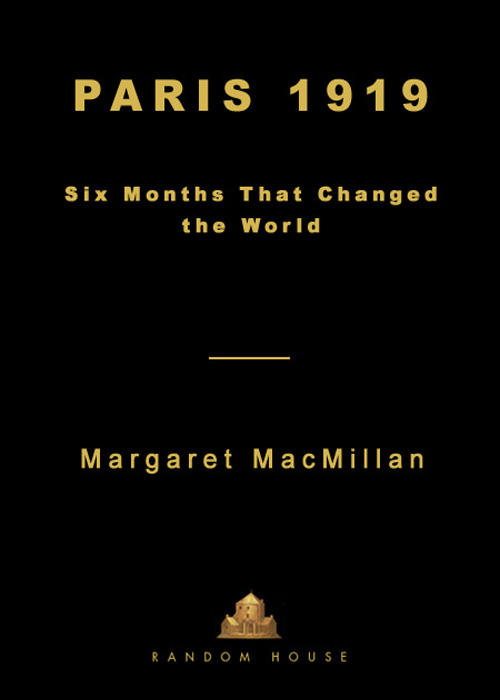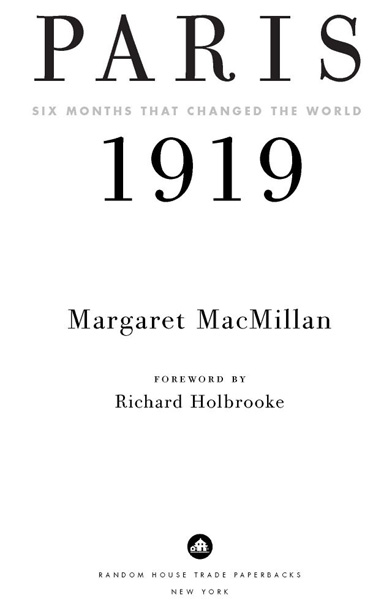PARIS 1919



Table of Contents
PART ONE - GETTING READY FOR PEACE
1 - Woodrow Wilson Comes to Europe
4 - Lloyd George and the British Empire Delegation
5 - We Are the League of the People
PART THREE - THE BALKANS AGAIN
13 - Punishment and Prevention
16 - Deadlock Over the German Terms
PART FIVE - BETWEEN EAST AND WEST
23 - Japan and Racial Equality
24 - A Dagger Pointed at the Heart of China
PART SEVEN - SETTING THE MIDDLE EAST ALIGHT
25 - The Greatest Greek Statesman Since Pericles
29 - Atatürk and the Breaking of Sèvres
To Eluned and Robert MacMillan
Praise for
PARIS 1919
“The history of the 1919 Paris peace talks following World War I is a blueprint of the political and social upheavals bedeviling the planet now. . . . A wealth of colorful detail and a concentration on the strange characters many of these statesmen were keep [Margaret MacMillan's] narrative lively.” â
The
New York Times Book Review
(Editors' Choice)
“Engrossing . . . Beautifully written, full of judgment and wisdom,
Paris
1919
is a pleasure to read and vibrates with the passions of the early twentieth century and of ours.” â
San
Francisco Chronicle
“So frequently do current events, particularly in the Balkans but also in the Middle East, take us back to the Paris Peace Conference that MacMillan's book often reads like the commentary on the daily newspaper. . . . [MacMillan] captures the spirit of the enterprise brilliantly. . . . Her book has already won many prizes, and it deserves them all.” â
The
Washington Post Book World
“Fine and memorable . . . a revelation into the history of such trouble spots as the Balkans, the Middle East, and, especially, Iraq . . . MacMillan is a superb writer who can bring history to life.” â
The
Philadelphia Inquirer
“[A] rich stew of a book . . . MacMillan spices her account with vivid anecdotes and brightly drawn character sketches.” â
St.
Louis Post-Dispatch
“Excellent . . . This is a sprawling work of narrative political history, filled with both diplomatic detail and vivid portraits of statesmen from across the world who converged on Paris in those dreary early months of 1919. . . . By combining impeccable research with lively prose and an eye for telling detail, MacMillan brings the diplomatic wranglings to life.” â
Los
Angeles Times Book Review
“For anyone interested in knowing how historic mistakes can morph into later historic problems, this brilliant book is a must-read.” âFort Worth
Star Telegram
“[A] consistently compelling work . . .
Paris
1919
is an amazingly detailed and wonderfully personal look at one of the most important peace conferences in modern history.” â
The Atlanta Journal-Constitution
“This is an enthralling book: detailed, fair, unfailingly lively.” â
The
Daily Telegraph
(London)
“MacMillan's scrupulously researched, very fluidly written and closely argued book forces us to reexamine our assumptions about the supposed myopia of Georges Clemenceau, David Lloyd George and Woodrow Wilson as they imposed their settlement on the defeated Central Powers and their allies.” â
The
Sunday Telegraph
(London)
Foreword
Richard Holbrooke
In diplomacy, as in life itself, one often learns more from failures than from successes. Triumphs will seem, in retrospect, to be foreordained, a series of brilliant actions and decisions that may in fact have been lucky or inadvertent, whereas failures illuminate paths and pitfalls to be avoidedâ in the parlance of modern bureaucrats, lessons learned. With this in mind, it is time to look again at what happened in Paris in 1919. Margaret MacMillan's engrossing account of that seminal event contains some success stories, to be sure, but measured against the judgment of history and consequences, it is a study of flawed decisions with terrible consequences, many of which haunt us to this day.
In the headline version of history, the road from the Hall of Mirrors to the German invasion of Poland only twenty years later is usually presented as a straight line. But as MacMillan forcefully demonstrates, this widely accepted view of history distorts the nature of the decisions made in Paris and minimizes the importance of actions taken in the intervening years.
The manner in which the war endedâwith an “armistice” and no fighting on German soilâplayed a significant role in subsequent events. “Things might have been different,” MacMillan writes, “if Germany had been more thoroughly defeated.” Most Germans outside the High Command did not realize that Germany was finished militarily, and therefore did not regard November 11, 1918, as a day of surrender. Hitler would capitalize on this; his promise to undo the Treaty of Versailles was a potent and popular theme during his rise to power. But MacMillan corrects the widely held view that the reparations payments imposed by the victors were so onerous as to have caused the wreck of the German economy that paved the way for Hitler.
By any standard, the cast of characters that assembled in Paris in 1919 was remarkable, from Lawrence of Arabia to a small Vietnamese kitchen hand later known as Ho Chi Minh. And for the first time in history, an American stood at the center of a great world drama. Woodrow Wilson inspired tens of millions who never met him, and frustrated those who worked with him. He was idealistic and remote, naïve and rigid, noble and conflicted. His strengths and weaknesses, his health, even the influence of his overbearing and ignorant wife, were all critical factors in events of historic importance.
In the eighty years since he left office, Wilson's reputation has risen and fallen regularlyâbut he remains as fascinating and central to an understanding of modern American foreign policy as ever. His many supporters, from Herbert Hoover to Robert McNamara, have argued that his enemies in both Paris and the United States Senate were responsible for the undoing of one of history's noblest dreams. Others, including Senator Jesse Helms, have viewed Wilson's determined adversary, Senator Henry Cabot Lodge, as a principled protector of American sovereignty and charged Wilson with seeking to undermine the American Constitution. Another school of thought, especially prevalent in the latter years of the Cold War, criticized Wilson for unrealistic, overly moralistic goals; among its best-known practitioners are George F. Kennan and Henry Kissinger, who accused Wilson of “extraordinary conceit,” even while conceding that he “originated what would become the dominant intellectual school of American foreign policy.” (To Kissinger's horror,
his
president, Richard Nixon, placed Wilson's portrait in the place of honor in the Cabinet Room.)
Through the fog of this never-ending debate, one thing is clear: as Wilson arrived in France in December 1918, he ignited great hopes throughout the world with his stirring Fourteen Pointsâespecially the groundbreaking concept of “self-determination.” Yet Wilson, often ill-informed or badly prepared for detailed negotiations, seemed vague as to what his own phrase actually meant. “When I gave utterance to those words,” he admitted later, “I said them without the knowledge that nationalities existed, which are coming to us day after day.”
Even at the time it was recognized that the concept of self-determination was, as MacMillan puts it, “controversial and opaque.” “When the President talks of âself-determination,'” Secretary of State Robert Lansing asked, “what unit has he in mind? Does he mean a race, a territorial area, or a community? . . . It will raise hopes which can never be realized. It will, I fear, cost thousands of lives. In the end it is bound to be discredited, to be called the dream of an idealist who failed to realize the danger until it was too late.”
Lansing was one of the first to recognize a dilemma that lies at the core of many of today's bitterest disputes. Still, it was not Wilson's dreams but his decision to compromise them (by letting Japan take the Shantung peninsula in China, for example) that cost the world so dearly. Ironically, when Wilson returned home, he made the opposite mistake: by refusing to make relatively minor compromises with Senate moderates, he lost his chance to get the treaty (and American membership in the League of Nations) ratified.
Some of the most intractable problems of the modern world have roots in decisions made right after the end of the Great War. Among them one could list the four Balkan wars between 1991 and 1999; the crisis over Iraq (whose present borders resulted from Franco-British rivalries and casual mapmaking); the continuing quest of the Kurds for self-determination; disputes between Greece and Turkey; and the endless struggle between Arabs and Jews over land that each thought had been promised them.
As the peacemakers met in Paris, new nations emerged and great empires died. Excessively ambitious, the Big Four set out to do nothing less than fix the world, from Europe to the far Pacific. But facing domestic pressures, events they could not control, and conflicting claims they could not reconcile, the negotiators were, in the end, simply overwhelmedâ and made deals and compromises that would echo down through history.
Even then, they sensed that they were laying the seeds for future problems. “I cannot say for how many years, perhaps I should say for how many centuries, the crisis which has begun will continue,” predicted Georges Clemenceau, whose own behavior contributed to the failure. “Yes, this treaty will bring us burdens, troubles, miseries, difficulties, and that will continue for long years.”
MacMillan brings back to life some great dramas: the Italian walkout after the failure of their effort to gain control of much of the Yugoslav coast; the Japanese grab of the Shantung peninsula, which launched the May Fourth Movement in China and started the path to war and revolution in Asia; the dismemberment of Hungary, which left millions of Hungarians permanently outside their own country's borders; the inability of the Big Four to deal with the new Soviet government, other than by sending a feckless expeditionary force into the Russian civil war; the dissolution of the Ottoman empire and the rise of one of the twentieth century's most remarkable leaders, Kemal Atatürk; and last but not least, the creation of Yugoslavia (originally, the Kingdom of the Serbs, Croats, and Slovenes) out of the disparate peoples of the south Balkans. This state would survive under Marshal Tito's communist dictatorship for decades, but when the patchwork put together in 1919 fell apart in the early 1990s, four wars followedâfirst Slovenia, then Croatia, then Bosnia-Herzegovina, and finally Kosovo. (A fifth, in Macedonia, was barely averted.)
As our American negotiating team shuttled around the Balkans in the fall of 1995 trying to end the war in Bosnia, the Versailles treaty was not far from my mind. Reading excerpts from Harold Nicolson's
Peacemaking
1919,
we joked that our goal was to undo Woodrow Wilson's legacy. When we forced the leaders of Bosnia, Croatia, and the Federal Republic of Yugoslavia to come together in Dayton, Ohio, in November 1995 and negotiate the end of the war, we were, in effect, burying another part of Versailles. In the spring of 2002, the last two parts of the Versailles creation still linked as “Yugoslavia” took another step, moving to the brink of a full and final divorce by agreeing to rename their country “Serbia and Montenegro”âprobably a way station on the path to full separation.
At Dayton we were working on only one small part of the puzzle; in Paris they worked on the world. Margaret MacMillan's brilliant portrait of the men of Paris, what they tried to do, where they succeeded, and why they failed, is especially timely now. This story illuminates, as only great history can, not only the past but also the present. It could help guide us in the future. I only regret that it was not available a decade ago. But here it is: an irresistible voyage through history.